Samarra Rises
In Iraq, the restoration of the shattered Mosque of the Golden Dome brings together Sunnis and Shiites in an unlikely alliance
/https://tf-cmsv2-smithsonianmag-media.s3.amazonaws.com/filer/Samarra-restoring-Shia-mosque-631.jpg)
I'm standing on a street corner in the center of Samarra—a strife-scarred Sunni city of 120,000 people on the Tigris River in Iraq—surrounded by a squad of American troops. The crackle of two-way radios and boots crunching shards of glass are the only sounds in this deserted neighborhood, once the center of public life, now a rubble-filled wasteland. I pass the ruins of police headquarters, blown up by an Al Qaeda in Iraq suicide truck bomber in May 2007, and enter a corridor lined by eight-foot-high slabs of concrete—"Texas barriers" or "T-walls," in U.S. military parlance. A heavily guarded checkpoint controls access to the most sensitive edifice in the country: the Askariya Shrine, or Mosque of the Golden Dome, one of the holiest sites in Shia Islam.
Here, in February 2006, Al Qaeda militants blew up the delicate gold-tile dome atop the thousand-year-old Shiite shrine, igniting a spasm of sectarian killing that brought the country to the edge of civil war. For the past year and a half, a committee led by Iraqi Prime Minister Nuri al-Maliki has been working with United Nations consultants to clear debris from the site and to begin rebuilding the Golden Dome—a $16 million project that aims to restore the shrine sufficiently to receive Shiite pilgrims by this summer.
I've been trying for three days to get close to the shrine, stymied by an order from al-Maliki's office barring journalists from the site—an indication of how sensitive the bombing remains in this country. U.S. military officers in Samarra have pulled strings on my behalf with the mayor, Iraqi police officials and the Ministry of Planning in Baghdad. This time, after I reach the checkpoint, a friendly commander of the Askariya Brigade, a predominantly Shiite police force dispatched from Baghdad last year to guard the site, makes a call to his superiors in the Iraqi capital, then escorts me through.
As I approach the shrine in the 120-degree heat, I take in evidence of battles between U.S. troops and Al Qaeda that ripped Samarra apart for five years, making it, according to one U.S. general, "the most destroyed city in Iraq." I pass a bullet-pocked hotel, shuttered trinket and mobile-phone shops, and a closed madrassah, or Islamic school. Heaps of debris have been neatly laid along both sides of the road. The stump of the once-glorious dome is now covered with wooden scaffolding. A few golden tiles still cling to jagged remnants of the bruised and broken structure. Near the main gate of the Askariya Shrine, I see the first sign of activity in an otherwise moribund landscape: a bulldozer, laden with fragments of the dome, rumbles through the portal toward a dumping ground nearby.
A dozen laborers bustle about the courtyard, which is filled with broken pillars and chunks of concrete bristling with exposed rebar. The whine of a pneumatic drill and the rhythmic pounding of a hammer resound from inside the shrine. "We have 120 workers on the site, working day and night, in two 12-hour shifts," Haidar al-Yacoubi tells me. A Shiite from Baghdad who has served as a technical adviser to the project since April, he adds: "Al Hamdulillah [praise God], the dome will rise again."
For nearly 11 centuries, the Askariya Shrine has been revered by Shiite Muslims as a symbol of sacrifice and martyrdom. The original building was constructed in A.D. 944, as the final resting place for Ali al-Hadi and his son, Hassan al-Askari, Shiite imams who had lived under house arrest—and were allegedly poisoned—at the military camp of the Sunni caliph al-Mu'tasim, when Samarra was the capital of the Islamic world. In 1905, the 150-foot dome, covered in 72,000 gold tiles and surrounded by pale-blue walls, was built above the shrine, signifying its importance; many of the faithful regard only the mosques of Najaf and Karbala as holier. Enhancing the sanctity of the compound is the adjacent Blue Mosque, built over a sardhab, or cellar, where Muhammad al-Mahdi, the Twelfth or Hidden Imam, withdrew and then disappeared in the ninth century. Shiites believe that al-Mahdi will one day rise from his "crypt" below the mosque, ushering in man's redemption and the end of the world.
For many Shiites, something close to the end of the world occurred on the morning of February 22, 2006, after eight Al Qaeda terrorists disguised in Iraqi military uniforms entered the shrine, overpowered guards, fixed explosives to the golden dome and blew it to pieces. The attack was a key part of Al Qaeda's strategy to foment civil war between Shiite and Sunni Muslims in Iraq, thereby sowing chaos, driving out occupying U.S. forces and turning the country into a fundamentalist caliphate. No one was killed in the attack, but within hours, as Al Qaeda's leadership had hoped, the violent spiral began: Shiite militants set fire to at least two dozen Sunni mosques in Baghdad and killed three imams. Sunnis retaliated by killing Shiites. Soon Baghdad—and much of the rest of Iraq—was caught in a vicious cycle of car bombings, kidnappings, murders and ethnic cleansing. By the end of that year, more than 10,000 people had died across the country. Samarra, meanwhile, sank deeper into destitution and despair, neglected by the Shiite-dominated government, avoided by contractors, and fought over by U.S. forces and a range of insurgent groups. "The city was dead," Mahmoud al-Bazzi, mayor of Samarra, tells me.
Today, however, after thousands of former Sunni insurgents came over to the American side; the "surge" of 30,000 U.S. troops ordered by President George W. Bush in early 2007 increased security; and a wave of successful U.S. and Iraqi strikes against Al Qaeda in Iraq put the terrorists on the defensive, the worst of Iraq's violence appears to be over. In Samarra, markets have come back to life and playgrounds are filled with children. And the very symbol of the country's descent into sectarian carnage—the Askariya Shrine—has brought together Sunnis and Shiites in a rebuilding effort. The endeavor, city officials and U.S. soldiers alike hope, will bring back hundreds of thousands of Shiite pilgrims from Iran, the Gulf States and beyond; restore Samarra's economic fortunes; and narrow Iraq's sectarian rift. "Rebuilding a Shia mosque in the heartland of the Sunni insurgency would have been unthinkable" less than a year ago, says Lt. Col. J. P. McGee, commander of the Second Battalion, 327th Infantry, based in Samarra since October 2007. "That's a powerful symbol of how Iraq has changed."
But peace in Samarra, as in the rest of Iraq, remains fragile. The city has become, in effect, a giant prison, isolated by an encircling berm, and divided by mazes of T-walls and sandbagged checkpoints. Remnants of Al Qaeda lurk in the surrounding desert, still recruiting among Samarra's youth and waiting for opportunities to strike. Prime Minister al-Maliki, deeply suspicious of Sunni paramilitary units outside the jurisdiction of the Shiite-dominated government, has moved to take control of the former insurgents, known as the Sons of Iraq, and drastically reduce their numbers. The Sons of Iraq have asserted that if they don't receive jobs—either in the Iraqi security forces or in public works projects—they could take up arms again. Should that happen, the tenuous security in Samarra that has made the shrine project possible could collapse overnight. Moreover, the effort itself, although showcased by the government as a powerful example of reconciliation, has been mired in political gamesmanship and sectarian suspicion for the past year, and its success is by no means assured.
I flew into Samarra by Black Hawk military helicopter from Baghdad on a steamy night early this past September, sweeping low over the Tigris River for much of the 70-mile, 45-minute journey. Although attacks against coalition forces have dropped dramatically, moving anywhere in the country remains risky: the next morning, I made the short journey from the airfield to the city in a vehicle called an MRAP (for mine-resistant ambush protected), a 38,000-pound armored behemoth with a 12-foot-high turret topped by a 50-caliber machine gun. The intimidating truck—also known as a Cayman—was introduced by the U.S. Army last February here in Salahuddin province to replace the Humvee, which is far more vulnerable to attacks by IEDs—improvised explosive devices. "The MRAPs have saved a lot of lives," a specialist riding in my Cayman told me. But they aren't foolproof: on July 9, 2008, Sgt. First Class Steven Chevalier—driving a Cayman through central Samarra—was killed by an RKG3 thermal grenade, a handheld canister filled with flammable pellets capable of penetrating armor. On August 15, a second RKG3 exploded inside another Cayman, critically burning four U.S. soldiers.
We crossed the Tigris over a dam; just downstream, hundreds of Iraqis were trying to beat the oppressive heat by swimming off a sandy bank. Soon we arrived at Patrol Base Olson, a Saddam-era casino built along the river and cut off from the rest of the city by rows of T-walls. This heavily fortified compound is the home of the 150 soldiers of Charlie Company, which has led the fight against Al Qaeda in Samarra, recruited fighters from the Sons of Iraq and helped secure the area around the Askariya Shrine. We pulled into the compound in a cloud of dust, and I stepped from the vehicle into a parking lot littered with bullet casings and crushed, half-empty water bottles. Inside the former casino—now Charlie Company's weapons depot, cafeteria, Internet café and Tactical Operations Center (TOC)—I was welcomed by Capt. Joshua Kurtzman, 29, the company commander. An army officer's son and West Point graduate who crossed from Kuwait with the original invasion force, Kurtzman was now serving his third tour in Iraq.
Sitting in his cluttered office at the TOC—one of the few corners of Patrol Base Olson with functioning air conditioning—Kurtzman recounted the marathon U.S. effort to bring Samarra under control during the past five years. U.S. forces arrived in the city in April 2003 and faced a growing insurgency within six months. A succession of U.S. offensives killed hundreds of militants and destroyed large parts of the city. But U.S. attempts to drive out the insurgents never succeeded. By late 2005, Al Qaeda controlled Samarra, with U.S. troops safe only inside Patrol Base Olson and a heavily fortified "Green Zone" adjacent to it.
Kurtzman recalled the dark days of Al Qaeda's rule in the city: militants cruised the streets with antiaircraft machine guns mounted on white Toyota pickup trucks. Public executions were held in Samarra's main market. Contractors, shopkeepers, even Sunni imams, were forced to hand over salaries to the militants. Ninety percent of the 40 or so fuel trucks destined for Samarra every few days were hijacked by Al Qaeda, their contents sold on the black market for up to $50,000 per truckload. In June 2007, militants again infiltrated the Askariya Shrine and blew apart the minarets. A month earlier, a suicide truck bomber had attacked police headquarters, killing the commander and 11 of his troops, and driving the rest of the force—700 men—out of the city. "We were fighting daily with Al Qaeda," said Kurtzman. "We had nine IEDs in a three-hour period on [one road through town]. Every patrol we went on, we were in a firefight or were encountering IEDs."
Then, in December 2007, the Iraqi government and its U.S. allies began to take back the city. The troops raised watchtowers and secured a berm that had been built around the city in 2005. Beginning a few months earlier, the Iraqi government had begun dispatching a national police brigade—4,000 strong—made up of both Sunnis and Shiites, along with a Kurdish battalion of the Iraqi Army. U.S. troops entered negotiations with Sunni insurgents, who had become fed up with Al Qaeda's tactics—including setting off car bombs inside Samarra. "Al Qaeda wanted to fight everybody," Abu Mohammed, leader of the Sons of Iraq in Samarra, told me. "They killed a lot of innocent people, from all levels of society." A deal was signed last February, and 2,000 Sunni fighters—many of whom had spent years arming IEDs to kill American troops—were given one to three days of weapons training.
The Sons of Iraq manned checkpoints and began feeding their new U.S. allies intelligence. "They'd say, 'My brother, who lives in this neighborhood, told me there's a cache here and there are six guys guarding it,'" Kurtzman recounted. U.S. and Iraqi forces conducted pinpoint raids, engaged Al Qaeda in firefights and, in time, drove its members out of Samarra. In an innovation first tried in Anbar province, U.S. troops also undertook a census of Samarra, registering every adult male in the city, scanning irises and taking fingerprints. According to U.S. Army data, hostile actions against American troops dropped from 313 in July 2007 to 5 in October 2008. "I sit here now and say, 'Man, I wish we'd thought of this two years ago,'" says Capt. Nathan Adams, who was based in Samarra in 2005 also. "But we were not ready then, and the Iraqi [insurgents] were not either. They needed to fight the superpower, to save face, then negotiate back to the middle ground." After six months of cooperation, "Al Qaeda's cells are dormant," Kurtzman told me. "They are hiding out in the middle of the desert, just trying to survive."
One evening I toured Samarra with Kurtzman and a platoon of soldiers from Charlie Company. We climbed into three Caymans and rumbled into the moonless night; the delicate turquoise dome of the Blue Mosque, bathed in fluorescent light, loomed just beyond the patrol base. It was the first week of Ramadan, and the streets were nearly deserted; most people were still at home for iftar, the feast at sundown that breaks the dawn-to-dusk fast. Only a few groceries, textile shops and restaurants were open, lit by small generators. Samarra's sporadic electricity was out again—no surprise in a city with few functioning services. "The Iraqi provincial government put half a million dollars into a water treatment plant, but there's no chlorine, so you might as well be drinking the Tigris with a straw," Kurtzman told me.
We dismounted and walked up the road to the main Sunni mosque in Qadisiya, an affluent quarter dominated during Saddam's time by high-level Baathists and army officers. Just a few months ago, Kurtzman said, troops returning to base from firefights with the militants would hear the muezzin call for jihad against America. But the main council of Sunni mosques in Iraq fired the imam last winter, and the radical messages stopped. "Six months ago, I would not have been standing right here," says Kurtzman. "I'd have been shot at." A crowd of children from an adjacent playground—a provincial government project completed a month ago—gathered around the platoon, along with a few adults. Kurtzman chatted them up, his interpreter by his side.
"It's good to see everybody outside tonight."
The kids clustered excitedly, trying out a few words of English, hoping for a pen or another small gift. "This must be the hottest place on earth right now," Kurtzman said. "The weather in Saudi Arabia is 105. It's 120 degrees here."
The men murmured their assent.
"So how much power are you getting here? Two hours on, five hours off?"
"Maybe a couple of hours during the day, a couple of hours at night. That's all."
A Sons of Iraq member stepped forward and began complaining about his employment prospects. I had been told that under intense pressure from the Iraqi government, the U.S. Army had dropped 200 Sunni fighters from its payroll in just the past month and would have to lay off another thousand in the months to come. In addition, salaries, now at $300 a month, were being renegotiated and could drop by a third. "There's a lot of anxiety out there," Kurtzman told me, as we climbed back into the Cayman.
From its earliest days, the effort to rebuild the Askariya Shrine has been beset by the violence and sectarian tensions that tormented so much of Iraq. Immediately after the bombing, then-Prime Minister Ibrahim al-Jaafari, a Shiite, called for United Nations help in restoring it. A few weeks later, Unesco representatives in Paris and Amman, Jordan, agreed to underwrite an Iraqi proposal to train Iraqi technicians and architects, and help rebuild not only the shrine, but Sunni mosques and churches across Iraq. In April 2006, a team from the Iraqi Ministry of Planning set out for Samarra by road for the first on-site assessment. The trip was aborted, however, after word reached the team that an ambush was planned by Al Qaeda. For months afterward, "We searched for international experts to go there, but the reaction was, 'No way,'" Mohamed Djelid, director of Unesco in Iraq, told me.
In June 2007, Unesco awarded a contract to Yuklem, a Turkish construction company, to conduct a feasibility study and make initial preparations—cleaning and production of architectural drawings—for the dome's reconstruction. "They sent one expert to Samarra, two times," Djelid said. Then came the destruction of the minarets in June 2007, which frightened off the Turks and made even some Unesco officials skittish about staying involved. "I myself was hesitating about whether Unesco should put our experts in this kind of situation," Djelid said. "But if we stopped, we were concerned about the consequences. What kind of message would that send?" Late that year came another setback: Turkish troops began pushing into Kurdish Iraq in pursuit of PKK Kurdish separatist guerrillas. In the face of an anti-Turkish backlash in Iraq, Yuklem became even more reluctant to send its technicians to Samarra.
But in December 2007, a small team of Unesco experts from across the Muslim world—Egyptians, Turks and Iranians—arrived in Samarra and set up an office near the Askariya Shrine. "The shrine was a mess, it was catastrophic, it was clear it was going to be a big challenge," said Djelid. Then the contract with the Turkish company, which had failed to begin work on the risky mission, was canceled. Al-Maliki appointed a task force to take control of the feasibility study, clear the site, and stabilize and protect what remained of the Golden Dome. But while the reconstruction project has been gaining momentum, it still remains enmeshed in sectarian politics. Some Sunnis in Samarra believe that al-Maliki's committee is acting as a front for Tehran, and that the presence of Iranians on the Unesco team is part of a plot to impose Shiite dominance in a Sunni city. "The Iranians have taken over this project," charges Suhail Najm Abed, a local Unesco consultant. "We threw out Al Qaeda, but we are bringing in another Hezbollah," referring to the Lebanese Shiite guerrilla group funded by Iran. For his part, Djelid defends using Iranian engineers: "[They] have a lot of expertise," he says. "When we discuss it with the population of Samarra, most tell us, 'If the Iranians are coming under the umbrella of Unesco, we have no problem.'"
Meanwhile, Unesco has been engaged in a debate with the Iraqi government about whether to rebuild the dome with modern materials or to remain faithful to the original construction, which could prolong the project by years. No one can predict with certainty when the dome will rise again. Unesco says that it expects only clean-up efforts and surveying to be completed by this summer.
On my last evening in Samarra, Kurtzman took me to meet Abu Mohammed, a former insurgent commander turned Sons of Iraq leader. As the muezzin from an adjacent mosque was blaring the post-iftar call to prayer, we pulled up in three Caymans to a handsome villa in Qadisiya. Abu Mohammed—an imposing and lean-faced man in his early 50s, clad in a white dishdasha, or traditional robe—greeted us in his courtyard and motioned for us to sit on plastic chairs arranged in a circle. Half a dozen other members of the Sons of Iraq welcomed us, including Abu Farouk, a hawk-nosed chain smoker and former tank driver in the Iran-Iraq war. Kurtzman had told me earlier that Abu Mohammed had led mortar teams against U.S. troops at the height of the Iraq insurgency, drawing on his experience as a rocket battalion commander in the Iraqi Army under Saddam. "In every country being occupied, there will be resistance," the former insurgent now began, balancing his 5-year-old son, Omar, in his lap. "And this is the legal right for any nation."
Abu Mohammed told me that his Sunni fighters had joined forces with the Americans last February only after their overtures to the Iraqi government had been rebuffed. "The U.S. was our last option," he acknowledged. "When the Americans came to this city, we didn't have a shared enemy. But now we have an enemy which both sides want to fight." The cooperation had been fruitful, Abu Mohammed said, yet he was concerned about the future. Al-Maliki's Shiite-dominated government was about to take control of the 53,000 Sunni fighters in Baghdad, and would soon turn its attention to Anbar and Salahuddin provinces. Despite talk of integrating the Sons of Iraq into the Iraqi security forces, he said, "we've tried to get the government to hire some of our fighters as policemen. But until now we didn't see a single person hired."
Kurtzman confirmed that even though Samarra's police force is woefully understrength, the Iraqi government was dragging its feet in hiring. "A Shia-dominated central government in a city that blew up one of the holiest shrines in the Shia world has a lot of bitterness against the people [of Samarra]," Kurtzman said. "That's why, in nine months, you haven't gotten police hired from here." Abu Mohammed insisted that his men were committed to peace, that rebuilding the shrine would benefit everyone in Samarra. But stability, he said, depended on jobs for the Sons of Iraq, and "we don't trust the Iraqi government."
Back at the Askariya Shrine, Haidar al-Yacoubi, the Shiite from Baghdad who serves as a technical adviser to the reconstruction project, gestured proudly at the workers sorting rubble in the courtyard. The integration of Shiites and Sunnis at the site, he said, would send a message to the world. "We don't make the Sunni-Shia difference important here," al-Yacoubi said, as we watched a Caterpillar bulldozer push debris through the mosaic-inlaid main gate. "Iraq is a kind of rainbow, so when we rebuild this mosque, we try to pick from each [group]." It remains to be seen, of course, whether such generous sentiments can be sustained—not only at the Mosque of the Golden Dome, but in Samarra and the rest of Iraq.
Freelance writer Joshua Hammer is based in Berlin.
Photographer Max Becherer lives in Cairo.
/https://tf-cmsv2-smithsonianmag-media.s3.amazonaws.com/accounts/headshot/Screen_Shot_2021-09-15_at_12.44.05_PM.png)
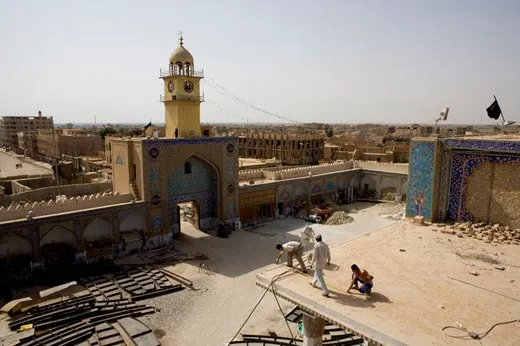
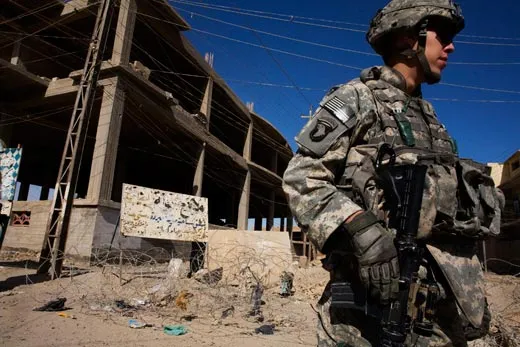
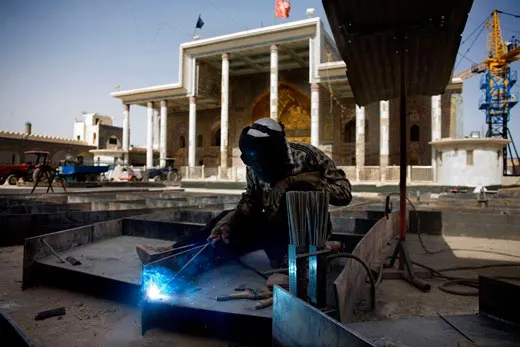
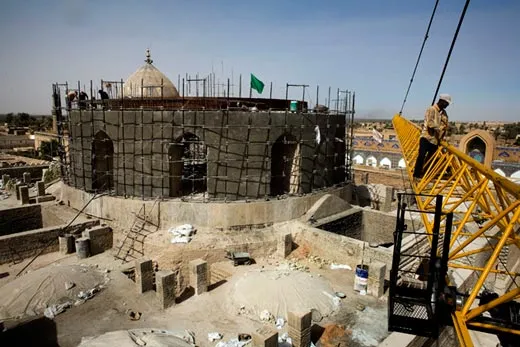
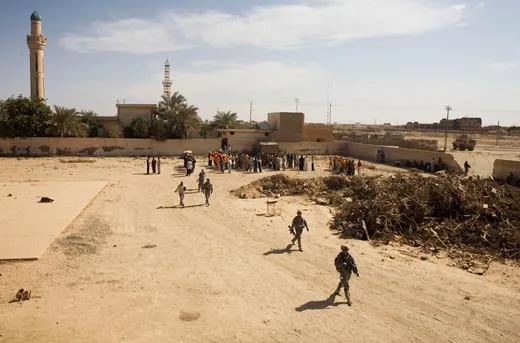
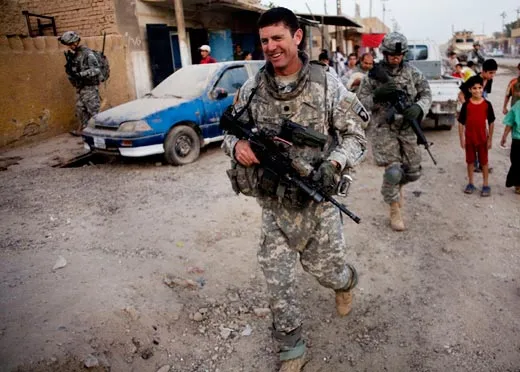
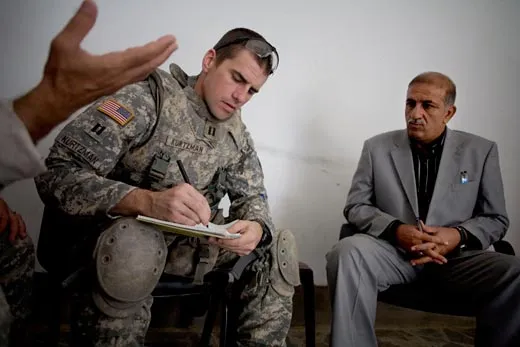
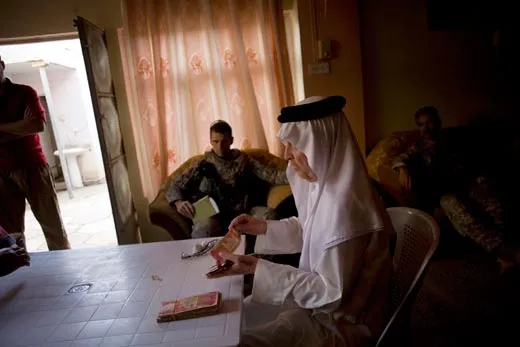
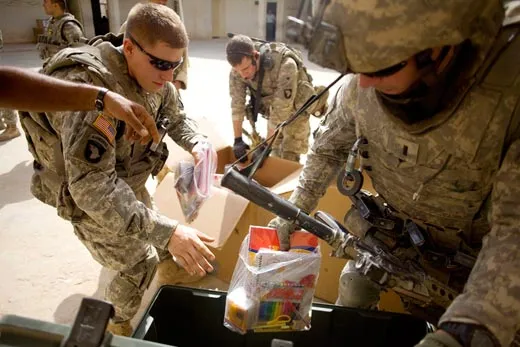
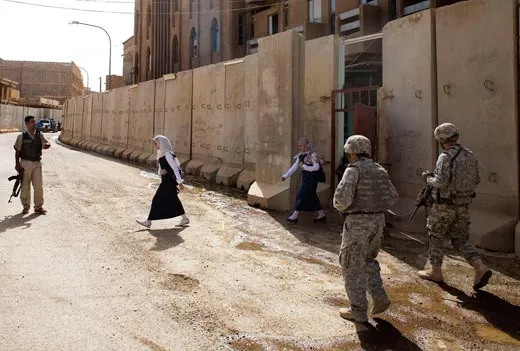
/https://tf-cmsv2-smithsonianmag-media.s3.amazonaws.com/accounts/headshot/Screen_Shot_2021-09-15_at_12.44.05_PM.png)